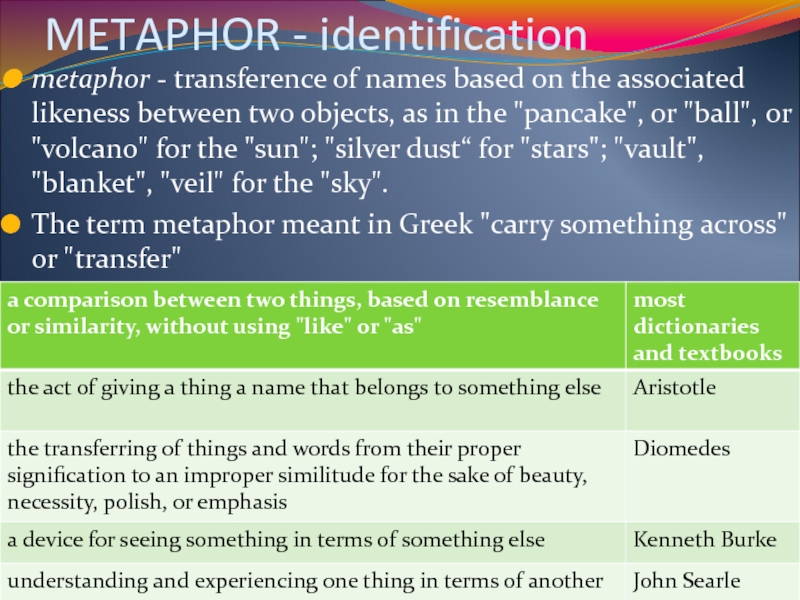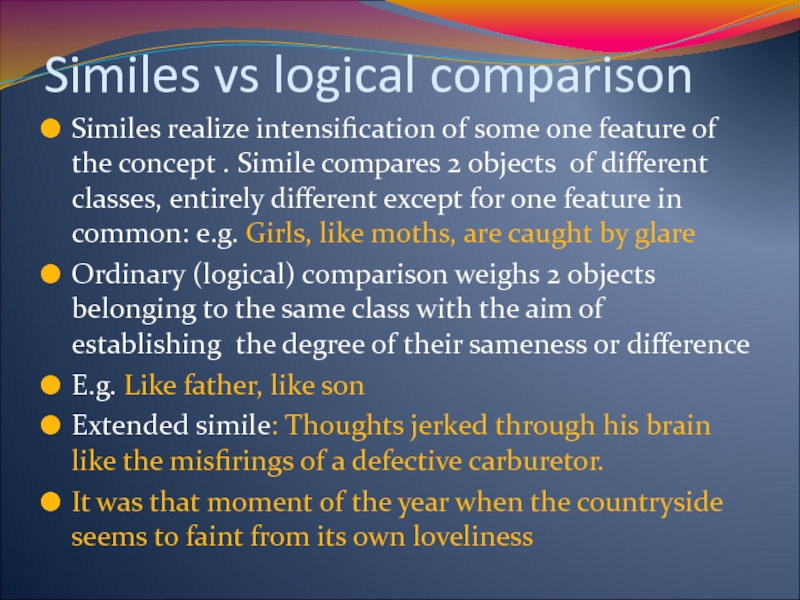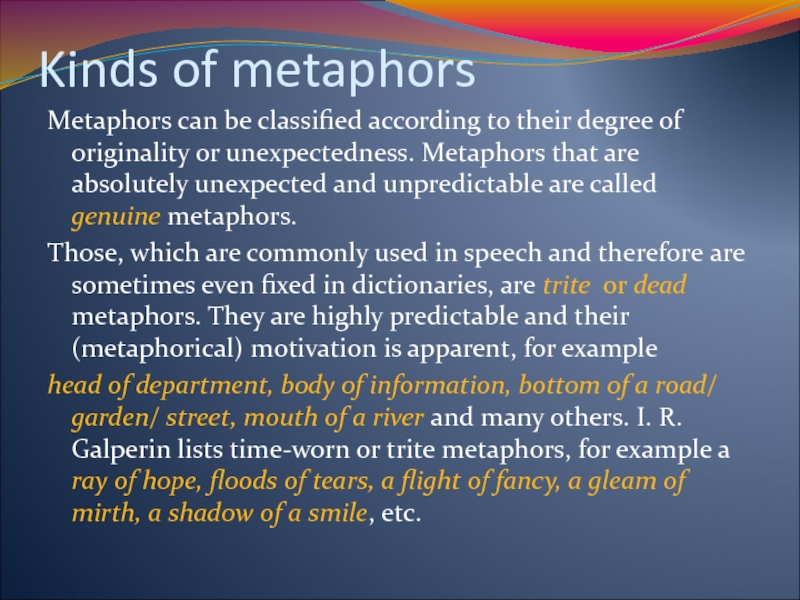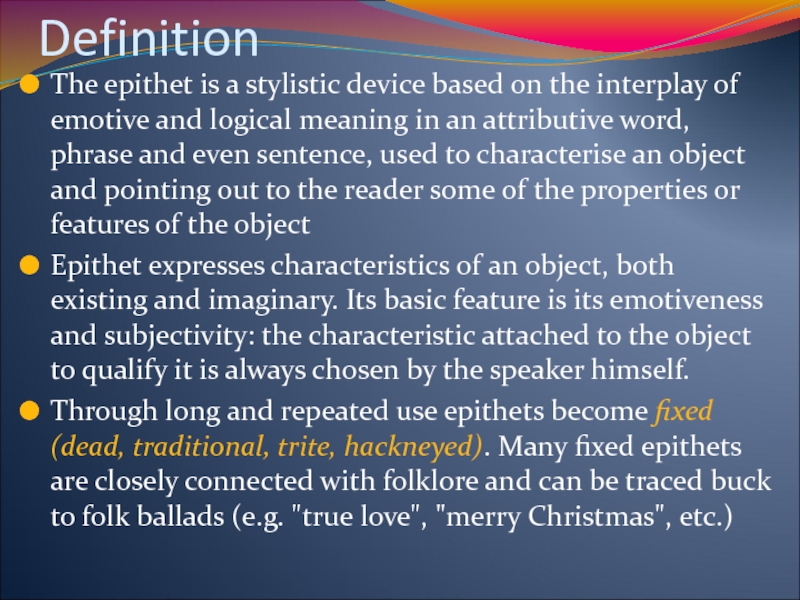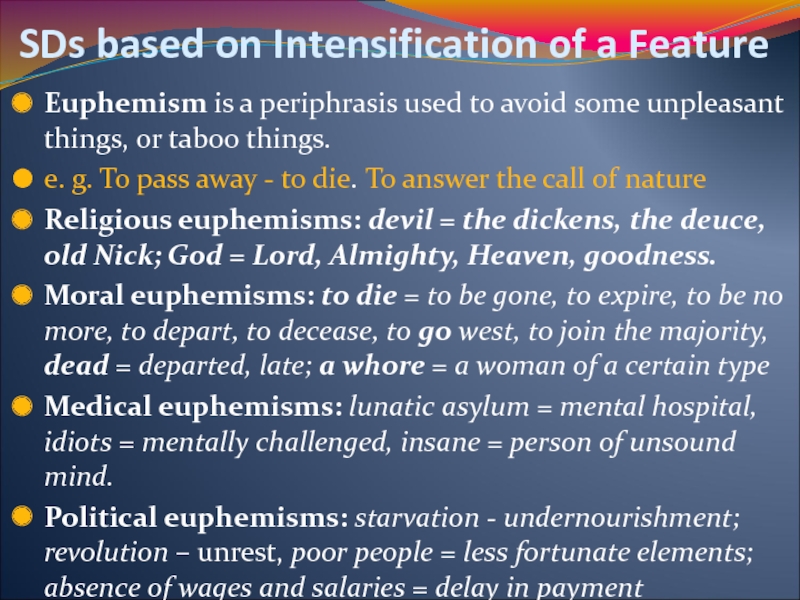- Главная
- Разное
- Дизайн
- Бизнес и предпринимательство
- Аналитика
- Образование
- Развлечения
- Красота и здоровье
- Финансы
- Государство
- Путешествия
- Спорт
- Недвижимость
- Армия
- Графика
- Культурология
- Еда и кулинария
- Лингвистика
- Английский язык
- Астрономия
- Алгебра
- Биология
- География
- Детские презентации
- Информатика
- История
- Литература
- Маркетинг
- Математика
- Медицина
- Менеджмент
- Музыка
- МХК
- Немецкий язык
- ОБЖ
- Обществознание
- Окружающий мир
- Педагогика
- Русский язык
- Технология
- Физика
- Философия
- Химия
- Шаблоны, картинки для презентаций
- Экология
- Экономика
- Юриспруденция
Stylistic semasiology. Lexical expressive means and stylistic devices презентация
Содержание
- 1. Stylistic semasiology. Lexical expressive means and stylistic devices
- 2. PLAN 1. Stylistic devices (SDs) based on
- 3. Literature Galperin – pp.136-190 Kukharenko – pp.23-27 Arnold – pp.82-102 Pelevina – pp.58-76
- 4. Meaning as the basis of semasiological stylistic
- 5. Types of Meaning pragmatic (directed at
- 6. Interactions of meaning
- 7. Stan Barstow's novel "Ask Me Tomorrow“(meaning of
- 8. Interaction of Different Types of Lexical Meaning
- 9. Interaction of Dictionary and Contextual Logical Meanings
- 10. METAPHOR - identification metaphor - transference of
- 11. A metaphor is a very common
- 12. UT clip “metaphors and similes”
- 13. SIMILE Similes compare two things using the
- 14. Similes vs logical comparison Similes realize intensification
- 15. Kinds of metaphors Metaphors can be classified
- 16. The expressiveness of the metaphor is
- 17. RELATED TERMS
- 18. Why use metaphors? They enliven ordinary language.
- 19. Creative ways to use metaphors
- 22. KINDS OF METAPHOR If a metaphor involves
- 23. Personification and allegory Personification is giving human
- 24. Allegory Allegory – a story which represents
- 25. Everyday metaphors Everyday speech also provides many
- 26. Specific functions are achieved by metaphors
- 27. Examples for analysis Dear Nature is our
- 28. Metonymy- substitution A metonymy involves substitution of
- 29. Lexical metonymy Mauser Maxim Levy’s Mackintosch,
- 30. Relationships metonymy is based on 1. A
- 31. Synecdochy (Greek “take up with something else”
- 32. Synecdoche It involves the substitution of a
- 33. Sentences for analysis She was too fond
- 34. Irony - opposition The essence of
- 35. UT clip about irony
- 36. Irony is a stylistic device also
- 37. Examples of irony I like the parliamentary
- 38. Irony: expression of something which is
- 39. SDs based on interrelation between denotational and emotional meanings: epithet, oxymoron
- 40. Definition The epithet is a stylistic device
- 41. Semantic groups affective (or emotive proper) epithets.
- 42. Structural (distributional) types Epithets are used singly,
- 43. More structural types Phrase-epithets always produce an
- 44. What kind of epithet? О dreamy, gloomy,
- 45. Oxymoron Oxymoron is a stylistic device the
- 47. Interjections and exclamations Interjections – words we
- 48. SD based on interrelation between nominative and
- 49. 3 groups of semasiological SDs 1. The
- 50. SDs based on interaction of primary and
- 51. PUN The pun is a S.D. based
- 52. “New cheese for the cheeseboard.” (A
- 53. Play on words may be based
- 54. SDs based on Intensification of a Feature
- 55. SDs based on Intensification of a Feature
- 56. Hyperbole Hyperbole is deliberate overstatement or exaggeration,
- 57. SDs based on Intensification of a Feature
- 58. 1. Christina's love is hungry: it
Слайд 2PLAN
1. Stylistic devices (SDs) based on interrelation between primary and derivative
1.1 metaphor vs simile
2. SDs based on interrelation between denotational and emotive meanings: oxymoron , epithet
3. SDs based on interrelation between nominal and contextual meanings: antonomasia
Слайд 4Meaning as the basis of semasiological stylistic devices
Meaning (L. Vygotsky) -
Various types of lexical meanings, the major one being denotational, which informs of the subject of communication; and also including connotational, which informs about the participants and conditions of communication.
Слайд 5Types of Meaning
pragmatic (directed at the desirable effect of the
associative (connected, through individual psychological or linguistic associations, with related and nonrelated notions),
ideological, or conceptual (revealing political, social, ideological preferences of the user),
evaluative (stating the value of the indicated notion),
emotive (revealing the emotional layer of cognition and perception),
expressive (aiming at creating the image of the object in question),
stylistic (indicating "the register", or the situation of the communication).
Слайд 7Stan Barstow's novel "Ask Me Tomorrow“(meaning of “pop”)
1. His face is
2. "Just pop into the scullery and get me something to stand this on."
3. "There is a fish and chip shop up on the main road. I thought you might show your gratitude by popping up for some."
4. "I've no need to change or anything then." "No, just pop your coat on and you're fine."
5. "Actually Mrs. Swallow is out. But she won't be long. She's popped up the road to the shops."
6. "Would you like me to pop downstairs and make you a cup of cocoa?"
Слайд 8Interaction of Different Types of Lexical Meaning
What is known in
The transferred meaning of a word may be fixed in dictionaries as a result of long and frequent use of the word other than in its primary meaning. In this case we register a derivative meaning of the word.
When, we perceive two meanings of the word simultaneously, we are confronted with a stylistic device in which the two meanings interact.
Слайд 9Interaction of Dictionary and Contextual Logical Meanings
The relationship between dictionary and
on the principle of symbol – referent relation, or substitution (i.e. metonymy)
on the principle of opposition(i.e. irony).
Слайд 10METAPHOR - identification
metaphor - transference of names based on the associated
The term metaphor meant in Greek "carry something across" or "transfer"
Слайд 11
A metaphor is a very common figure or trope which has
A metaphor states that something is equivalent to another thing which is not usually associated with it.
Metaphors are not only found in literary works, but are actually quite common in language in general. However, many metaphors in everyday use are described as dead metaphors, as they have been used so frequently that their metaphorical character has become less apparent. When one describes one's feelings as 'up' or 'down' or when one describes oneself as 'fuming mad' or as 'bubbling with enthusiasm', one is using dead metaphors.
Слайд 13SIMILE
Similes compare two things using the words like or as, seems,
Hackneyed similes: The morning dew was as bright as diamond
As busy as a
As cold as a bee, bat, post, crystal , herring,
As pale as a oyster, mule, beetle, paper
As blind as a horse, cucumber, doornail,
As strong as a
As dead as a
As deaf as a
As clear as a
As dumb as an
As stubborn as a
Слайд 14Similes vs logical comparison
Similes realize intensification of some one feature of
Ordinary (logical) comparison weighs 2 objects belonging to the same class with the aim of establishing the degree of their sameness or difference
E.g. Like father, like son
Extended simile: Thoughts jerked through his brain like the misfirings of a defective carburetor.
It was that moment of the year when the countryside seems to faint from its own loveliness
Слайд 15Kinds of metaphors
Metaphors can be classified according to their degree of
Those, which are commonly used in speech and therefore are sometimes even fixed in dictionaries, are trite or dead metaphors. They are highly predictable and their (metaphorical) motivation is apparent, for example
head of department, body of information, bottom of a road/ garden/ street, mouth of a river and many others. I. R. Galperin lists time-worn or trite metaphors, for example a ray of hope, floods of tears, a flight of fancy, a gleam of mirth, a shadow of a smile, etc.
Слайд 16
The expressiveness of the metaphor is promoted by the implicit simultaneous
Слайд 18Why use metaphors?
They enliven ordinary language.
They are generous to readers and
They are more efficient and economical than ordinary language; they give maximum meaning with a minimum of words.
They create new meanings; they allow you to write about feelings, thoughts, things, experiences, etc. for which there are no easy words; they are necessary.
They are a sign of genius.
Слайд 21 Speaker Ground (unhappy with his bank manager): Bankers are powerful, influential
Слайд 22KINDS OF METAPHOR
If a metaphor involves likeness between inanimate and animate
Metaphor, as all other SDs, is fresh, original, genuine, when first used, and trite, hackneyed, stale when often repeated. In the latter case it gradually loses its expressiveness becoming just another entry in the dictionary, as in the "leg of a table" or the "sunrise", thus serving a very important source of enriching the vocabulary of the language.
Metaphor can be expressed by all notional parts of speech, and functions in the sentence as any of its members.
When the speaker (writer) in his desire to present an elaborated image does not limit its creation to a single metaphor but offers a group of them, each supplying another feature of the described phenomenon, this cluster creates a sustained (prolonged) metaphor.
Слайд 23Personification and allegory
Personification is giving human qualities to something that is
Objects: The lights blinked in the distance
The moon is a harsh mistress
Your computer hates me
Concepts: Time marches on
It is not nice to fool Mother Nature
Animals: The birds expressed their joy
The groundhog hovered indecisively
Слайд 24Allegory
Allegory – a story which represents an idea or belief, is
Слайд 25Everyday metaphors
Everyday speech also provides many examples of metaphoric expressions.
woman),
basket case(a nervous wreck or someone who is mentally incapacitated;
patients in mental hospitals are often taught basket-weaving skills),
culture vulture (a person who is excessively and indiscriminately interested in the arts),
Egghead (an intellectual),
a good egg or a bad egg (a nice person or a dubious character),
Faceless man (a person who is not known to the public, but who uses power behind the
scenes),
headshrink or headshrinker (humorous and informal expression for a psychoanalyst or a psychiatrist, now shortened to shrink),
shrinking violet (humorous and informal word for a person who lacks self-confidence, a shy person),
Muckrakers (the name given to US investigative journalists and writers using excessive
sensationalism at the beginning of the 20th century),
yellow journalism (the methods 41 of the muckracking press), etc.
She’s got her claws into him, ...he messed up with a bad egg, ...their relationship bit the
dust, ...she pulled wool around his eyes.
Слайд 26
Specific functions are achieved by metaphors used in newspapers. The following
...political parties have learnt their lesson..., ... the government decided behind the closed door...,
...Europeans looking forward to their new money..., ...there were few members of Congress without skeleton in their closets...,
... young generation heading for the promised land..., ...their recent campaign has come to nothing...,
...local directors keeping them in dark...,
...Clinton doesn’t seem to notice he is playing with fire here.
Слайд 27Examples for analysis
Dear Nature is our kindest Mother (Byron) – attributive
In the slanting beams that streamed though the open window the dust danced and was golden (O.Wilde) – verbal m.
The leaves fell sorrowfully – adverbial m.
Ray of hope, a storm of indignation, a flight of fancy, flood of tears, shadow of a smile – hackneyed, trite metaphor
Mr. Pickwick bottled up his vengeance and corked it down..Mr Domby’s cup of satisfaction was so full at this moment, however, that he felt he could afford a drop or two of its contents even to sprinkle on the dust in the by=path of his little daughter (Dickens). – sustained m.
Слайд 28Metonymy- substitution
A metonymy involves substitution of one by another or the
Metonymy is based on a different type of relationship between the dictionary and contextual logical meanings, a relationship based on some kind of association connecting the two concepts which the meanings present
For example, the word crown can stand for a king or queen, cup or glass for the drink it contains, woolsack for the Chancellor of the Exchequer who sits on it, or the position and dignity of the Lord Chancellor
Слайд 30Relationships metonymy is based on
1. A concrete thing is used instead
‘The camp, the pulpit and the law For rich men’s sons and free.’ (P. B. Shelley)
2.The container instead of the thing contained:
‘The hall applauded.’ ‘He drank two glasses and left.’ ‘I managed just a cup.’
3.The relation of proximity:
‘The ballroom was glittering and happy.’ ‘The city was horrified and scared to death!’
4.The material instead of the thing made :
‘The gold was stolen.’ ‘The iron is hot.’ ‘He was taken away in irons.’
5.The instrument which the doer uses in performing the action instead of the action or the doer himself:
‘Well, Mr. Weller, says the gentleman, you’re a very good whip and can do what you like with your horses, we know.’(Dickens)
Слайд 31Synecdochy (Greek “take up with something else” )as a special case
Five main types of synecdochy
1. pars pro toto: Ukraine mourns dead from Lviv air show. Tell us what happened. We’re all ears! Could you give me a hand with this heavy table?
2. totum pro parte
3. species pro genere
4. genus pro specie
5. singularis pro plurari
Слайд 32Synecdoche
It involves the substitution of a part for the whole, or
Washington and London (= USA and UK) agree on most issues; He was followed into the room by a pair of heavy boots (= by a man in heavy boots); cf. the Russian: "Да, да ", ответили рыжие панталоны (Чехов). In a similar way, the word crown (to fight for the crown) may denote "the royal power/the king"; the word colours in the phrase to defend the colours of a school denotes the organization itself.
'John had gone into the room and drank the only bottle of Coke that I had'
Слайд 33Sentences for analysis
She was too fond of a bottle. The press,
They came in. Two of them, a man with long fair moustache and a silent dark man. Definitely the moustache and I had nothing in common.
And I also have given you cleanness of teeth in all your cities, and want of bread in all your places.
Bell, book and candle shall not drive me back.
The pen is mightier than the sword.
As the sword is the worst argument that can be used, so should it be the last.
There was something very agreeable in being so intimate with such a waistcoat, in being on such off-hand terms with such a pair of whiskers…
The camp, the pulpit ans the law for rich men’s sons are free
The hall applauded. The round game table was happy. The marble spoke…
Слайд 34Irony - opposition
The essence of irony consists in the foregrounding
Irony thus is a stylistic device in which the contextual evaluative meaning of a word is directly opposite to its dictionary meaning, an indirect naming of a phenomenon
in which the meaning is shifted towards the opposite pole
J. Steinbeck's "She turned with the sweet smile of an alligator,“
Слайд 36
Irony is a stylistic device also based on the simultaneous realization
“It must be delightful to find oneself in a foreign country without a penny in one’s pocket.”
Irony can be considered as an extreme case of a metaphor, however, metaphor is based on the relation of homonymy while irony is based on antonymy - verbal irony
Sustained type of irony is formed by the contradiction of the speaker's (writer's) considerations and the generally accepted moral and ethical codes
Слайд 37Examples of irony
I like the parliamentary debate
Particularly when it is not
I like a beefsteak, as well as any;
Have no objections to a pot of beer.
I like the weather when it is not too rainy –
that is I like two months of every year
(Byron)
Слайд 38
Irony: expression of something which is contrary to the intended meaning;
*Yet Brutus says he was ambitious;
And Brutus is an honourable man. Shakespeare, Julius Caesar
Metaphor: implied comparison achieved through a figurative use of words; the word is used not in its literal sense, but in one analogous to it.
*Life's but a walking shadow; a poor player,
That struts and frets his hour upon the stage. Shakespeare, Macbeth
*From Stettin in the Baltic to Trieste in the Adriatic, an iron curtain has descended across
the continent. W. Churchill
Metonymy: substitution of one word for another which it suggests.
*He is a man of the cloth
*The pen is mightier than the sword.
*By the sweat of thy brow thou shalt eat thy bread
Слайд 40Definition
The epithet is a stylistic device based on the interplay of
Epithet expresses characteristics of an object, both existing and imaginary. Its basic feature is its emotiveness and subjectivity: the characteristic attached to the object to qualify it is always chosen by the speaker himself.
Through long and repeated use epithets become fixed (dead, traditional, trite, hackneyed). Many fixed epithets are closely connected with folklore and can be traced buck to folk ballads (e.g. "true love", "merry Christmas", etc.)
Слайд 41Semantic groups
affective (or emotive proper) epithets. These epithets serve to convey
figurative, or transferred, epithets - is formed of metaphors, metonymies and similes expressed by adjectives. E.g. "the smiling sun", "the frowning cloud", "the sleepless pillow", ''the tobacco-stained smile", "a ghost-like face", "a dream-like experience".
Associated: fantastic terrors, careful attention
Unassociated: bootless cries sullen earth, voiceless sands
Слайд 42Structural (distributional) types
Epithets are used singly, in pairs, in chains, in
Two-step epithets - the process of qualifying passes two stages: the qualification of the object and the qualification of the qualification itself, as in "an unnaturally mild day”, or "a pompously majestic female".
Слайд 43More structural types
Phrase-epithets always produce an original impression : "the sunshine-in-the-breakfast-room
inverted (syntactical, reversed) epithets - based on the contradiction between the logical and the syntactical: logically defining becomes syntactically defined and vice versa. E.g. instead of "this devilish woman", W. Thackeray says "this devil of a woman“, "the giant of a man" (a gigantic man), "the toy of a girl" (a small, toylike girl), "the kitten of a woman" (a kittenlike woman), Just a ghost of a smile appeared on his face; she is a doll of a baby.
Слайд 44What kind of epithet?
О dreamy, gloomy, friendly trees! Rich, full, high
my true love; a sweet heart; the green wood; a dark forest; brave cavaliers; merry old England
The brute of a boy, the shadow of a smile, the devil of a job, the pig of a boy
Do-it-yourself attitude; mystery-making, come-hither-but go-away-again-because-butter-wouldn’t-melt-in-my-mouth expression of Gioconda
Desperate core of rattling hearts, pioneering appropriation of masculine tailoring
Слайд 45Oxymoron
Oxymoron is a stylistic device the syntactic and semantic structures of
a living corpse; sweet sorrow; a nice rascal; awfully (terribly) nice; a deafening silence; a low skyscraper.
little big man, the poorest millionaire, sweet sorrow, nice rascal, pleasantly ugly face, horribly beautiful, deafening silence, poor little rich girl, unpleasant pleasure, adult children, blind eye, buried alive, agree to disagree, a little pregnant
Слайд 47Interjections and exclamations
Interjections – words we use when we express our
Wow! Oops! Auch! Aha! Yummy! Ugh! Yukky! Tut,tut!
Byron “Don Juan”:
All present life is but an interjection
An “oh” or “ah” of joy or misery
Or a “ha, ha” or “bah’ – a yawn of “pooh”
Of which perhaps the latter is most true
Exclamations – are the words that may retain some logical meaning, though suppressed by emotive one.
Heavens! God! Good gracious! Look out! Bless me! Come on! Dear! Fine! Boy! Terrible! Man! Splendid!
Слайд 48SD based on interrelation between nominative and logical meanings: antonomasia
Antonomasia is
1 type: Th. Dreiser : "He took little satisfaction in telling each Mary something...." He is the Napoleon of crime (= a genius in crime as great as Napoleon was in wars); You are a real Cicero
2 type: when a common noun serves as an individualizing name: "There are three doctors in an illness like yours. Dr. Rest, Dr. Diet and Dr. Fresh Air." Mister Know-all; Miss Toady, Miss Sharp (W.Thackeray); Mr. Murdstone (Ch.Dickens)
Society is now one polished horde, formed of two mighty tribes, the Bores and the Bored.” (G. G. Byron)
Слайд 493 groups of semasiological SDs
1. The interaction of different types of
a) dictionary and contextual (metaphor, metonymy, irony);
b) primary and derivative (zeugma and pun);
c) logical and emotive (epithet, oxymoron);
d) logical and nominative (autonomasia);
2. Intensification of a feature (simile, hyperbole, periphrasis).
Peculiar use of set expressions (cliches, proverbs, epigram, quotations).
Слайд 50SDs based on interaction of primary and derivative meanings (zeugma and
Zeugma is the use of a word in the same grammatical but different semantic relations to two adjacent words in the context, the semantic relations being on the one hand literal, and on the other, transferred.
e. g. Dora, plunged at once into privileged intimacy and into the middle of the room.
Moira in the bar was dispensing champagne and bright laughs in copious qualities,...”
“Mr. Well’s hair, manner, and eyes were all out of control,...”
Let’s have a dance ere we are married, that we may lighten our own hearts and our wives’ heels. (Shakespeare)
Слайд 51PUN
The pun is a S.D. based on the interaction of two
e.g.- Did you miss my lecture ?
Not at all.
Seven days without water make one weak.
“Bow to the board,” said Bumble. Oliver brushed away two or three tears that were lingering in his eyes; and seeing no board but the table, fortunately bowed to that. (Ch. Dickens)
Слайд 52
“New cheese for the cheeseboard.” (A slogan advertising new cheese for
“My dog is a champion boxer.” (A saying based on homophony of the word boxer: a breed or a fighter.)
“Prince of Wails.” (The title of an article about Prince of Wales.)
“Bald ambitions.” (The title of an article about bold ambitions of a bald musician.)
“The Hole Truth.” (The title of an article about the pop group The Hole. The meaning of the word whole should be inferred.)
“Why is six afraid of seven? Because seven ate nine.”
(A joke based on homophony: eight/ate.)
Слайд 53
Play on words may be based upon polysemy and homonymy:
a) Visitor, to
Is your mother engaged?
Engaged ? She is already married;
b) A young lady, weeping softly into her mother's lap:
My husband just can't bear children!
He needn't bear children, my dear. You shouldn't expect too much of your husband.
Play on words may be based upon similarity of pronunciation:
John said to Pete at dinner: "Carry on". But Pete never ate carrion.
Слайд 54SDs based on Intensification of a Feature
Periphrasis is a round-about way
e. g. The fair sex. My better half.
Periphrases are divided into:
1. Logical - based on inherent properties of a thing.
e. g. Instrument of destruction (weapon), the subject of administration (President, king, prime minister).
2. Figurative - based on imagery: metaphor, metonymy
e. g. To tie a knot - to get married; in disgrace of fortune - bad luck. Love = the most pardonable of human weaknesses. Money= root of all evil
Слайд 55SDs based on Intensification of a Feature
Euphemism is a periphrasis used
e. g. To pass away - to die. To answer the call of nature
Religious euphemisms: devil = the dickens, the deuce, old Nick; God = Lord, Almighty, Heaven, goodness.
Moral euphemisms: to die = to be gone, to expire, to be no more, to depart, to decease, to go west, to join the majority, dead = departed, late; a whore = a woman of a certain type
Medical euphemisms: lunatic asylum = mental hospital, idiots = mentally challenged, insane = person of unsound mind.
Political euphemisms: starvation - undernourishment; revolution – unrest, poor people = less fortunate elements; absence of wages and salaries = delay in payment
Слайд 56Hyperbole
Hyperbole is deliberate overstatement or exaggeration, the aim of which is
e. g. A thousand pardons, scared to death, immensely obliged. Mary was scared to death. Pete knows everybody in the town. Every single rascal tries to cheat the public here.
Hyperbole can be expressed by all notional parts of speech. The most typical cases of expression are: by pronouns (all, every, everybody, everything); by numerical nouns (a million, a thousand); by adverbs of time (ever, never).
Слайд 57SDs based on Intensification of a Feature
Meiosis is a deliberate diminution
There was not a drop of water left in the bucket.It was a cat-size pony.August can do the job in a second.Their house is one minute from here. The guy is so disgusting! He is a real microbe.She was a pocket-size woman
Litotes is a specific variant of meiosis. It is a combination of the negative particle "not" and a word with negative meaning or a negative prefix. He is not without sense of humour. The mission was not impossible









